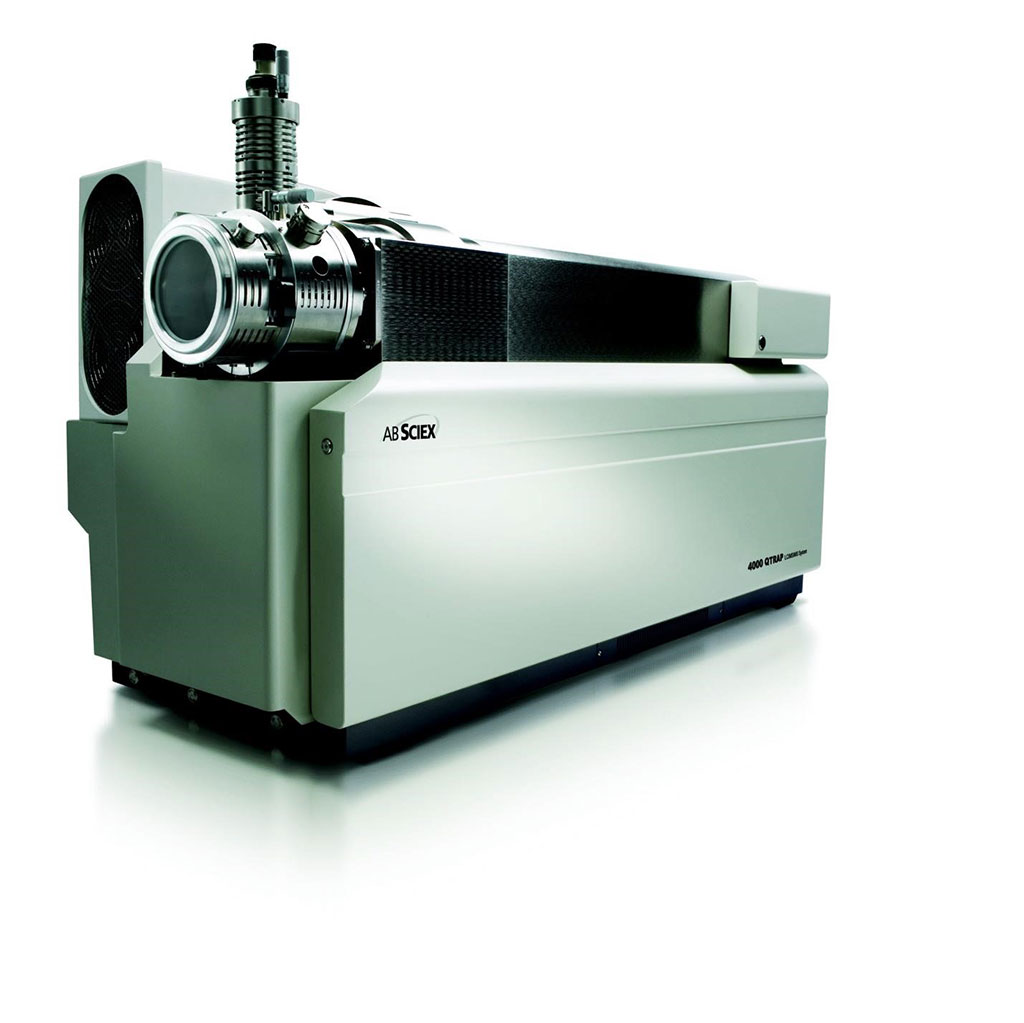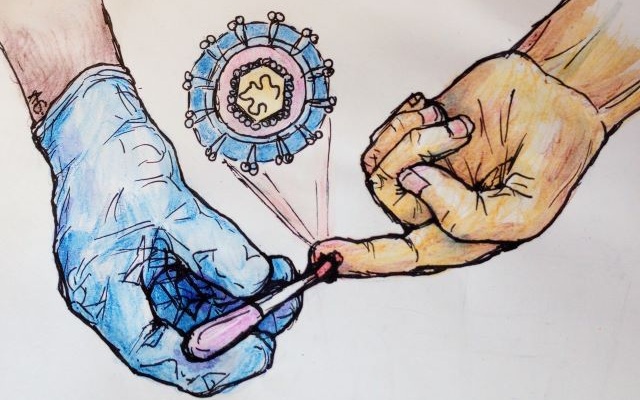Dolichol Biomarker Evaluated for Congenital Disorders of Glycosylation
|
By LabMedica International staff writers Posted on 14 Aug 2020 |

The AB MDS SCIEX API4000 tandem mass spectrometer (Photo courtesy of SCIEX).
A congenital disorder of glycosylation (CDG; previously called carbohydrate-deficient glycoprotein syndrome) is one of several rare inborn errors of metabolism in which glycosylation of a variety of tissue proteins and/or lipids is deficient or defective.
CDG often cause serious, sometimes fatal, malfunction of several different organ systems (especially the nervous system, muscles, and intestines) in affected infants. Dolichol is a membrane lipid which carries monosaccharides and glycans for N-linked protein glycosylation occurring in the endoplasmic reticulum.
Scientists from the Charles University and General University Hospital (Prague, Czech Republic) analyzed urine samples from 75 controls, six patients with CDG ((NUS1-CDG, SRD5A3-CDG, two with PMM2-CDG, PGM1-CDG, DPAGT1-CDG), and 43 patients with suspicion of CDG. Furthermore, tissue homogenates (frontal cortex, skeletal muscle, heart and liver) from two NUS1-CDG patients and two controls (at the age 0–5 years) were also analyzed. The dolichol ratio determination was established as a non-invasive screening method and evaluated through a screening for rare CDG syndromes.
The urine and tissue samples were processed and homogenized with a 4710 Series Ultrasonic Homogenizer, (Cole Parmer, Vernon Hills, IL, USA). The dolichols (Dol) were analyzed by using the AB MDS SCIEX API4000 tandem mass spectrometer (Applied Biosystems, Foster City, CA, USA) coupled with Agilent 1290 Infinity UPLC System (Agilent Technologies, Santa Clara, CA, USA).
The dolichol 18 to dolichol 19 (Dol18/Dol19) ratio biomarker was compared in urine samples with different CDGs to evaluate its use for identifying these disorders. The investigators reported that in the control group, a significant correlation between the ratio of Dol18/Dol19 and age was found in urine. They established a reference range for Dol18/Dol19 from the urine samples. The ratio of Dol18/Dol19 was significantly higher in both urine and tissue samples from patients with mutation in NUS1 in comparison to controls.
The authors concluded that their results on test samples show a novel diagnostic option for patients with rare congenital disorders of glycosylation, especially for those with pathological mutations in NUS1, who cannot be detected by usual screening methods. The study was published in the August, 2020 issue of the journal Clinica Chimica Acta.
Related Links:
Charles University and General University Hospital
Cole Parmer
Applied Biosystems
Agilent Technologies
CDG often cause serious, sometimes fatal, malfunction of several different organ systems (especially the nervous system, muscles, and intestines) in affected infants. Dolichol is a membrane lipid which carries monosaccharides and glycans for N-linked protein glycosylation occurring in the endoplasmic reticulum.
Scientists from the Charles University and General University Hospital (Prague, Czech Republic) analyzed urine samples from 75 controls, six patients with CDG ((NUS1-CDG, SRD5A3-CDG, two with PMM2-CDG, PGM1-CDG, DPAGT1-CDG), and 43 patients with suspicion of CDG. Furthermore, tissue homogenates (frontal cortex, skeletal muscle, heart and liver) from two NUS1-CDG patients and two controls (at the age 0–5 years) were also analyzed. The dolichol ratio determination was established as a non-invasive screening method and evaluated through a screening for rare CDG syndromes.
The urine and tissue samples were processed and homogenized with a 4710 Series Ultrasonic Homogenizer, (Cole Parmer, Vernon Hills, IL, USA). The dolichols (Dol) were analyzed by using the AB MDS SCIEX API4000 tandem mass spectrometer (Applied Biosystems, Foster City, CA, USA) coupled with Agilent 1290 Infinity UPLC System (Agilent Technologies, Santa Clara, CA, USA).
The dolichol 18 to dolichol 19 (Dol18/Dol19) ratio biomarker was compared in urine samples with different CDGs to evaluate its use for identifying these disorders. The investigators reported that in the control group, a significant correlation between the ratio of Dol18/Dol19 and age was found in urine. They established a reference range for Dol18/Dol19 from the urine samples. The ratio of Dol18/Dol19 was significantly higher in both urine and tissue samples from patients with mutation in NUS1 in comparison to controls.
The authors concluded that their results on test samples show a novel diagnostic option for patients with rare congenital disorders of glycosylation, especially for those with pathological mutations in NUS1, who cannot be detected by usual screening methods. The study was published in the August, 2020 issue of the journal Clinica Chimica Acta.
Related Links:
Charles University and General University Hospital
Cole Parmer
Applied Biosystems
Agilent Technologies
Latest Clinical Chem. News
- Blood Test Could Predict and Identify Early Relapses in Myeloma Patients
- Compact Raman Imaging System Detects Subtle Tumor Signals
- Noninvasive Blood-Glucose Monitoring to Replace Finger Pricks for Diabetics
- POC Breath Diagnostic System to Detect Pneumonia-Causing Pathogens
- Online Tool Detects Drug Exposure Directly from Patient Samples
- Chemical Imaging Probe Could Track and Treat Prostate Cancer
- Mismatch Between Two Common Kidney Function Tests Indicates Serious Health Problems
- VOCs Show Promise for Early Multi-Cancer Detection
- Portable Raman Spectroscopy Offers Cost-Effective Kidney Disease Diagnosis at POC
- Gold Nanoparticles to Improve Accuracy of Ovarian Cancer Diagnosis
- Simultaneous Cell Isolation Technology Improves Cancer Diagnostic Accuracy
- Simple Non-Invasive Hair-Based Test Could Speed ALS Diagnosis
- Paper Strip Saliva Test Detects Elevated Uric Acid Levels Without Blood Draws
- Prostate Cancer Markers Based on Chemical Make-Up of Calcifications to Speed Up Detection
- Breath Test Could Help Detect Blood Cancers
- ML-Powered Gas Sensors to Detect Pathogens and AMR at POC
Channels
Molecular Diagnostics
view channel
Blood Test Combined with MRI Brain Scans Reveals Two Distinct Multiple Sclerosis Types
Multiple sclerosis (MS) affects more than 2.8 million people worldwide, yet predicting how the disease will progress in individual patients remains difficult. Current MS classifications are based on clinical... Read more
Ultra-Sensitive Blood Biomarkers Enable Population-Scale Insights into Alzheimer’s Pathology
Accurately estimating how many people carry Alzheimer’s disease pathology has long been a challenge, as traditional methods rely on small, clinic-based samples rather than the general population.... Read more
Blood Test Could Predict Death Risk in World’s Most Common Inherited Heart Disease
Hypertrophic cardiomyopathy (HCM) is the world’s most common inherited heart condition and affects millions of people globally. While some patients live with few or no symptoms, others develop heart failure,... Read moreHematology
view channel
MRD Tests Could Predict Survival in Leukemia Patients
Acute myeloid leukemia is an aggressive blood cancer that disrupts normal blood cell production and often relapses even after intensive treatment. Clinicians currently lack early, reliable markers to predict... Read more
Platelet Activity Blood Test in Middle Age Could Identify Early Alzheimer’s Risk
Early detection of Alzheimer’s disease remains one of the biggest unmet needs in neurology, particularly because the biological changes underlying the disorder begin decades before memory symptoms appear.... Read more
Microvesicles Measurement Could Detect Vascular Injury in Sickle Cell Disease Patients
Assessing disease severity in sickle cell disease (SCD) remains challenging, especially when trying to predict hemolysis, vascular injury, and risk of complications such as vaso-occlusive crises.... Read more
ADLM’s New Coagulation Testing Guidance to Improve Care for Patients on Blood Thinners
Direct oral anticoagulants (DOACs) are one of the most common types of blood thinners. Patients take them to prevent a host of complications that could arise from blood clotting, including stroke, deep... Read moreImmunology
view channel
Ultrasensitive Liquid Biopsy Demonstrates Efficacy in Predicting Immunotherapy Response
Immunotherapy has transformed cancer treatment, but only a small proportion of patients experience lasting benefit, with response rates often remaining between 10% and 20%. Clinicians currently lack reliable... Read more
Blood Test Could Identify Colon Cancer Patients to Benefit from NSAIDs
Colon cancer remains a major cause of cancer-related illness, with many patients facing relapse even after surgery and chemotherapy. Up to 40% of people with stage III disease experience recurrence, highlighting... Read moreMicrobiology
view channel
New UTI Diagnosis Method Delivers Antibiotic Resistance Results 24 Hours Earlier
Urinary tract infections affect around 152 million people every year, making them one of the most common bacterial infections worldwide. In routine medical practice, diagnosis often relies on rapid urine... Read more
Breakthroughs in Microbial Analysis to Enhance Disease Prediction
Microorganisms shape human health, ecosystems, and the planet’s climate, yet identifying them and understanding how they are related remains a major scientific challenge. Even with modern DNA sequencing,... Read morePathology
view channel
Genetics and AI Improve Diagnosis of Aortic Stenosis
Aortic stenosis is a progressive narrowing of the aortic valve that restricts blood flow from the heart and can be fatal if left untreated. There are currently no medical therapies that can prevent or... Read more
AI Tool Simultaneously Identifies Genetic Mutations and Disease Type
Interpreting genetic test results remains a major challenge in modern medicine, particularly for rare and complex diseases. While existing tools can indicate whether a genetic mutation is harmful, they... Read more
Rapid Low-Cost Tests Can Prevent Child Deaths from Contaminated Medicinal Syrups
Medicinal syrups contaminated with toxic chemicals have caused the deaths of hundreds of children worldwide, exposing a critical gap in how these products are tested before reaching patients.... Read more
Tumor Signals in Saliva and Blood Enable Non-Invasive Monitoring of Head and Neck Cancer
Head and neck cancers are among the most aggressive malignancies worldwide, with nearly 900,000 new cases diagnosed each year. Monitoring these cancers for recurrence or relapse typically relies on tissue... Read moreTechnology
view channel
Pioneering Blood Test Detects Lung Cancer Using Infrared Imaging
Detecting cancer early and tracking how it responds to treatment remains a major challenge, particularly when cancer cells are present in extremely low numbers in the bloodstream. Circulating tumor cells... Read more
AI Predicts Colorectal Cancer Survival Using Clinical and Molecular Features
Colorectal cancer is one of the most common and deadly cancers worldwide, and accurately predicting patient survival remains a major clinical challenge. Traditional prognostic tools often rely on either... Read moreIndustry
view channel
BD and Penn Institute Collaborate to Advance Immunotherapy through Flow Cytometry
BD (Becton, Dickinson and Company, Franklin Lakes, NJ, USA) has entered into a strategic collaboration with the Institute for Immunology and Immune Health (I3H, Philadelphia, PA, USA) at the University... Read more


















